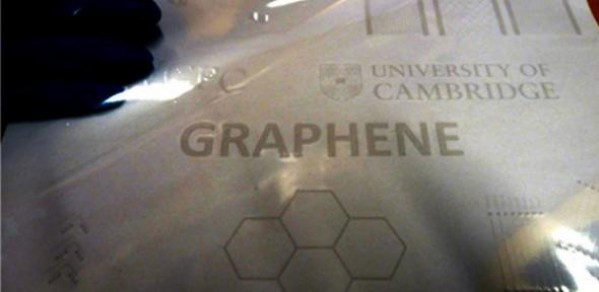
Scientists working with Europe's Graphene Flagship and the Cambridge Graphene Centre have produced a detailed and wide-ranging review of the potential of graphene and related materials in energy conversion and storage.
We hope that our critical overview will guide researchers in academia and industry ... with an eventual benefit for society as a whole
Professor Andrea Ferrari
In a review article published recently in the journal Science, the researchers, led by Francesco Bonaccorso, a Royal Society Newton Fellow at the Cambridge Graphene Centre, note the substantial progress made in material preparation at the laboratory level. They also highlight the challenge of producing the materials on an industrial scale in a cost-effective manner.
Graphene - a two-dimensional material made up of sheets of carbon atoms – has many potential applications, among them energy conversion and storage. Graphene and related 2D crystals combine high electrical conductivity with physical flexibility and a huge surface to weight ratio. Such qualities make them suitable for storing electric charge in batteries and supercapacitors and as catalysts in solar and fuel cell electrodes.
“The huge interest in 2D crystals for energy applications comes both from their physico-chemical properties, and the possibility of producing and processing them in large quantities, in a cost-effective manner,” said Francesco. “In this context, the development of functional inks based on 2D crystals is the gateway for the realisation of new generation electrodes in energy storage and conversion devices.”
Francesco added that the challenge ahead is to demonstrate a disruptive technology in which two-dimensional materials not only replace traditional electrodes, but more importantly enable whole new device concepts.
“Graphene and related materials have great promise in these areas, and the Graphene Flagship has identified energy applications as a key area of investment,” said review co-author Professor Andrea Ferrari, who chairs the Executive Board of the Graphene Flagship, and is director of the Cambridge Graphene Centre. “We hope that our critical overview will guide researchers in academia and industry in identifying optimal pathways toward applications and implementation, with an eventual benefit for society as a whole
The Graphene Flagship, a pan-European 10-year, €1 billion science and technology programme was launched in 2013.
Now with 142 partners in 23 countries, and a growing number of associate members, the Graphene Flagship was established following a call from the European Commission to address big science and technology challenges of the day through long-term, multidisciplinary research and development efforts.
In an open-access paper published in the Royal Society of Chemistry journal Nanoscale, more than 60 academics and industrialists lay out a science and technology roadmap for graphene, related two-dimensional crystals, other 2D materials, and hybrid systems based on a combination of different 2D crystals and other nanomaterials. The roadmap covers the next ten years and beyond, and its objective is to guide the research community and industry toward the development of products based on graphene and related materials.
Graphene and related materials are expected to revolutionise the fields in which they are applied, and they have the potential to become the materials of the 21st century. They will supplement, and at times replace, existing substances in a range of applications. Two-dimensional materials shall in some cases be integrated into existing platforms in order to enhance them. For example, graphene could be integrated into silicon photonics, exploiting established technology for constructing integrated circuits.
The roadmap highlights three broad areas of activity. The first task is to identify new layered materials, assess their potential, and develop reliable, reproducible and safe means of producing them on an industrial scale. Identification of new device concepts enabled by 2D materials is also called for, along with the development of component technologies. The ultimate goal is to integrate components and structures based on 2D materials into systems capable of providing new functionalities and application areas.
Eleven science and technology themes are identified in the roadmap. These are: fundamental science, health and environment, production, electronic devices, spintronics, photonics and optoelectronics, sensors, flexible electronics, energy conversion and storage, composite materials and biomedical devices. The roadmap addresses each of these areas in turn, with timelines.
Research areas outlined in the roadmap correspond broadly with current flagship work packages, with the addition of a work package devoted to the growing area of biomedical applications, to be included in the next phase of the flagship. A recent independent assessment has confirmed that the Graphene Flagship is firmly on course, with hundreds of research papers, numerous patents and marketable products to its name.
Roadmap timelines predict that, before the end of the ten-year period of the flagship, products will be close to market in the areas of flexible electronics, composites and energy, as well as advanced prototypes of silicon-integrated photonic devices, sensors, high-speed electronics and biomedical devices.
"This publication concludes a four-year effort to collect and coordinate state-of-the-art science and technology of graphene and related materials," says Professor Ferrari. "We hope that this open-access roadmap will serve as the starting point for academia and industry in their efforts to take layered materials and composites from laboratory to market." Professor Ferrari led the roadmap effort with Francesco Bonaccorso.
"We are very proud of the joint effort of the many authors who have produced this roadmap," says Jari Kinaret, director of the Graphene Flagship. "The roadmap forms a solid foundation for the graphene community in Europe to plan its activities for the coming years. It is not a static document, but will evolve to reflect progress in the field, and new applications identified and pursued by industry."

